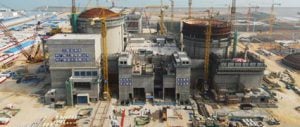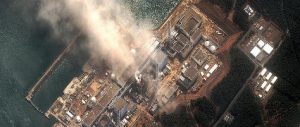On the first night of the 1959 nuclear reactor meltdown at Santa Susana Field Laboratory (SSFL) in California, John Pace was a new trainee. He arrived at the facility – a federal defence contractor compound located in hills some 50 kilometres from downtown Los Angeles – just after radiation had been vented from an overheating reactor to prevent it from exploding. “After leaking the gases, they discovered that the winds were headed toward the San Fernando Valley,” said Pace. “All of our families lived [there] and all that radiation went over their homes.”
Faced with massive radioactive contamination, the operators used crude methods to clean it up. “We scrubbed it down with water and sponges. We tried mops,” recalled Pace, the last surviving witness from that night. “They’d get contaminated real quick and that was getting pretty expensive, so we ended up using [sanitary napkins].” In the end, the crisis went on for two weeks: each time the reactor – a sodium reactor experiment (SRE) – cooled down, the operators started it up again and, again, it overheated. Highly radioactive gases that had built up due to the extreme heat had to be released to prevent the reactor from exploding and were secretly vented each night.
So much radiation was eventually emitted that this still has the distinction of being the worst nuclear accident in the country’s history. In 2006, a study by the University of California, Los Angeles, estimated that the reactor released 260 to 459 times as much radiation into the environment as the Three Mile Island accident in the state of Pennsylvania, levels the authors said could translate to between 300 and 1,800 cancer deaths.
Half a century later, the story still goes on. A basic agreement was signed in December to clean up SSFL, which over the years has housed 10 nuclear reactors, a plutonium fuel fabrication facility and a lab for cutting up irradiated nuclear fuel from around the country, plus rocket-testing and munitions-development facilities. But the parties with responsibility for the site – NASA, California, the Department of Energy and Boeing – are still wrangling over the details of the cleanup and are embroiled in two court cases. As the US decides whether or not to embark on a nuclear revival, many argue this incident and its aftermath offer a warning from history.
Dan Hirsch, president of non-profit organisation Committee to Bridge the Gap – an anti-nuclear lobby group that has been battling to get the SSFL compound cleaned up for more than 30 years – is one such voice. “People today are not remembering what happened the last time we went deeply into nuclear power,” he said. “We had meltdowns and horrible accidents that now we are spending billions of dollars unsuccessfully trying to clean up.”
Even now, the US Department of Energy (DOE) is still unsure of the full facts surrounding the 1959 reactor meltdown. DOE spokesman Bill Taylor told chinadialogue: “We know there was the fuel meltdown. We don’t know how much or if any was released. [We] don’t know exactly what happened 50 years ago.”
At first, the public was not even told that anything had happened. Then, five weeks after the incident, a news release was issued saying that there had been an event, but that no danger had been posed to the public. The truth partly came out 20 years later, when a University of California Los Angeles (UCLA) researcher accidentally came upon archive material. And then, in 2009, Pace came forward to give his version of events, out of concern that the facts were being concealed.
Local people may not have been informed about developments, but they were affected. Bonnie Klea, now 68, contracted bladder cancer after working at SSFL for eight years and living close to the facility for decades. She has been proactive in convincing the federal government to expand its worker compensation programme. Klea told chinadialogue that, until recently, the government programme to compensate federal energy workers was based on readings from radiation badges. However, at SSFL, the badges were collected by the facility and have now gone missing. Klea filed a petition to compensate more SSFL workers, which was approved in 2009.
Radiation impacts are not the only concern. Hirsch’s campaign has also focused on the cleanup of dangerous chemicals that were regularly used in unsafe practices at the site. The carcinogen trichloroethylene (TCE), for example, was used to wash down stands used for rocket tests, subsequently making its way into the surrounding environment, said Hirsch: “Half a million gallons of TCE are estimated to have migrated into the groundwater and deep soil.” He continued: “Groundwater was badly contaminated, and only belatedly stopped being used for drinking water onsite.”
Hirsch added that contaminated process water was used for irrigation and cleaning throughout the site, spreading the pollution and sending plumes of toxic steam into the air and the neighbouring communities.
A programme to pump and treat the tainted area began in the 1980s, explained Hirsch, but only removed 10 gallons of TCE a year: “At that rate, it would take 50,000 years of pumping to remove the TCE – except the pumping has been shut down since 2000.” Meanwhile, a quarter of the water wells in Simi Valley, which has a population of more than 100,000, have been found to be contaminated with perchlorate, a chemical that disrupts iodine uptake.
In 2008, Hirsch testified before a United States senate hearing on cleanup efforts at public facilities. He explained that illegal practices had continued at SSFL up to the mid-1990s when, long after open-air burning of hazardous materials was supposed to have stopped at the site, an explosion killed two workers. The FBI raided the facility and the US Attorney issued felony charges. The operators eventually pleaded guilty to three environmental felonies and received a US$6.5 million fine (42.9 million yuan).
After more than 50 years of radioactive, chemical, and toxic heavy-metal contamination, a basic clean-up deal was signed on December 6 last year. The agreement between the state of California, NASA (which owns a stake in the site) and the US Department of Energy (DOE) guarantees that the much-delayed remediation of the highly contaminated site will be carried out to the strictest standard – that of agricultural land. The programme is expected to complete by 2017.
The primary purpose of the agreement is to provide a blueprint for the NASA and DOE clean-up efforts. It was prompted by decades of disagreements between the various stakeholders of the compound and the state regarding the acceptable final standard of the cleanup.
US aerospace and defence corporation Boeing, which owns the majority of the 2,800-acre property, did not sign the agreement. The firm had previously agreed to pay US$22.5 million (148.4 million yuan) to the state each year for 30 years for site maintenance and committed to restore the land to residential standards – a less stringent requirement than set out by the new deal. Boeing filed a lawsuit in federal court against California in November 2009, claiming that only the federal government has jurisdiction to regulate the site. The case is expected to continue into 2011. Boeing also stated that it is suing to reserve its legal rights to challenge the cleanup standard set by the state. The case is expected to go to court this summer.
As the squabbling continues, Hirsch hopes that the lessons from the 1959 environmental disaster – and other practices as SSFL – will not be ignored. The contaminated site still poses a serious pollution threat to the air, land and water supplies in an area populated by half a million people.
“Who would have thought,” asks Hirsch, “that in the midst of the Cold War, the only American victims of radiation would be caused by our own government?”
Joan Bien is a freelance journalist based in California.
Homepage image from the US Department of Energy shows SSFL in 1958.

